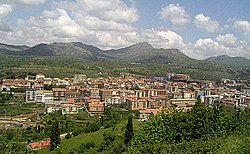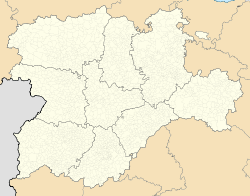Béjar
Béjar | |
|---|---|
 | |
| Coordinates: 40°23′N 5°46′W / 40.383°N 5.767°W | |
| Country | |
| Autonomous community | |
| Province | Salamanca |
| Comarca | Sierra de Béjar |
| Judicial district | Béjar |
| Founded | 400 BC |
| Government | |
| • Alcalde | Alejo Riñones Rico (2011) (PP) |
| Area | |
| • Total | 46 km2 (18 sq mi) |
| Elevation | 959 m (3,146 ft) |
| Population (2016)[2] | |
| • Total | 13,403 |
| • Density | 290/km2 (750/sq mi) |
| Demonym | bejarano |
| Time zone | UTC+1 (CET) |
| • Summer (DST) | UTC+2 (CEST) |
| Postal code | 37700 |
| Dialing code | 923 |
| Website | www |
Béjar is a town and municipality in the province of Salamanca, western Spain, part of the autonomous community of Castile and León. It had a population of 15,016 as of 2017.
History
This section needs expansion. You can help by adding to it. (October 2008) |
The first inhabitants of what is now Béjar were the Vettones who settled an area to the south of the city now known as La Antigua around 400 BC. The city formed part of Roman Hispania in the beginning of the 1st century BC. In AD 713, the city was taken by Muslim Berbers (Moors) from the Visigoths and in the 11th century it was conquered by King Alfonso VI of Castile. Following this, the walls, part of which still stands, are constructed to repel frequent Arab incursions that took place until the definitive conquest.
The city was later the center of the Duchy of Béjar ruled by the powerful House of Zúñiga.
- Semana Santa's feast day 2009
Name
The name Béjar is of pre-Roman origin. The original form was Bigerra[3] and is said to mean "place of the beehives." Béjar could be an adaption from the Spanish word abeja, which means "bee." An older spelling of the city's name is Béxar. In medieval documents, Vexar is found also.
Bexar County in the U.S. state of Texas acquired its name indirectly from this city.
Monuments
Béjar has many remarkable monuments and historical buildings [4]:
- City walls: well-preserved medieval fort
- Church of Saint James (Santiago): built in XII century, now serves as a Museum of Religious Art
- Church of Saint Mary the Great (Santa María la Mayor): Built between XII and XVII centuries, in several different architect styles (from mudejar to baroque)
- Jewish Museum David Melul: shows Béjar's Hebrew past
- Ducal Palace and Camera Obscura: Ancient fortress transformed into a Palace for the Duke and Duchess of Béjar in XVI century.
See also
References
- ^ a b "Municipio:Béjar". www.lasalina.es (in Spanish). Retrieved 2017-10-28.
- ^ "Salamanca: Población por municipios y sexo". www.ine.es (in Spanish). Retrieved 2017-10-28.
- ^ Edward Gibbon. History of the Decline and Fall of the Roman Empire. Volume 5. Claxton, Remsen & Haffelfinger, 1873. p. 258.
- ^ "Conoce B̩jar РExcmo. Ayuntamiento de B̩jar" (in European Spanish). Retrieved 2019-01-22.
External links
- i-Béjar web portal Template:Es icon






